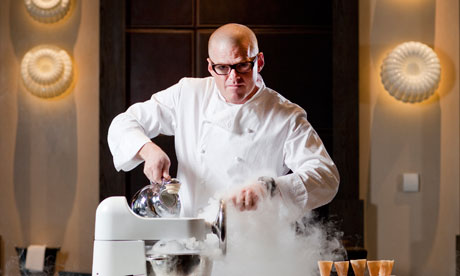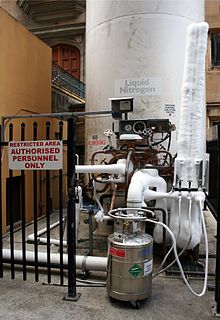When appropriately insulated from ambient heat, liquid nitrogen can be stored and transported, for example in vacuum flasks. Here, the very low temperature is held constant at 77 K by slow boiling of the liquid, resulting in the evolution of nitrogen gas. Liquid nitrogen is produced commercially from the cryogenic distillation of liquified air. An air compressor is used to compress filtered air to high pressure; the high pressure gas is cooled back to ambient temperature, and allowed to expand to a low pressure. The expanding air cools greatly ( the Joule Thomson effect), and oxygen, nitrogen, and argon are separated by further stages of expansion and distillation. Liquid nitrogen may be produced for direct sale, or as a byproduct of manufacture of liquid oxygen used for industrial processes such as steelmaking. Liquid air plants producing on the order of tons per day of product started to be built in the 1930's but became very common after the Second World War; a large modern plant may produce 3000 tons/day of liquid air products.
The properties of liquid nitrogen make it ideal for Freezing and transport of food products, Cryopreservation of biological samples, Coolant for superconductors, Cryotherapy, Shielding materials from oxygen exposure and Cooling materials for easier machining or fracturing. In a culinary research laboratory, chefs use this ultra-cold liquid to cryopoach oils, cryoshatter cheese, cryopowder herbs and cryograte meat. It is great for making instant ice cream and perfectly cooked hamburgers. For many years the coldest substance chefs had ready access to was dry ice (frozen carbon dioxide), which sublimates directly to CO2 gas at –109 degrees Fahrenheit. Although dry ice has some interesting culinary uses, its solid form limits its utility.
Nitrogen boils at a far colder temperature: –321 degrees F, about as many degrees below zero as hot fryer oil is above zero. And because nitrogen melts before it vaporizes, unlike carbon dioxide, it is relatively easy to store as a liquid and pour over food or into a bowl. Because its viscosity is about one-fifth that of water and it has relatively low surface tension, liquid nitrogen flows rapidly into nooks and crannies in foods, such as hamburger patties, that have rough or irregular surfaces. The cooks at our lab use it to make fantastic burgers that are first slow-cooked to medium rare, then dunked briefly in liquid nitrogen to freeze a thin layer of the exterior and, finally, deep-fried. The deep-frying creates a perfect brown crust and thaws the frozen layer but does not overcook the interior.
If swallowed, liquid nitrogen can cause cold burns to the mouth, throat and stomach, killing the tissue. As the frozen vapour hits the stomach it rapidly warms, releasing large volumes of air which can burst the stomach. Only recently this october 4th an 18-year-old reported to have become breathless, developed severe stomach pain before being taken to Royal Lancaster Infirmary. Officers say she would have died if doctors had not performed the operation. The woman, from Heysham in Lancashire, was taken from Oscar's wine bar to hospital at 11pm. She was diagnosed with a perforated, or pierced stomach, and is now in a serious but stable condition. A police statement said: "The premises involved have fully co-operated with all agencies and have suspended drinks involving liquid nitrogen. "The investigation is still in its early stages and we are still interviewing witnesses to establish the full facts. The force said they had been warning other bars in the town about what had happened. Doctor John Ashton, director of public health for Cumbria, said: "This girl is the victim of an irresponsible alcohol industry that's now competing on gimmicks.
Chef Heston Blumenthal has popularised the use of liquid nitrogen in cooking, using it to make food including ice cream. In cocktails it is usually used to freeze ingredients, to chill glasses or as a visual gimmick.
The Food Standards Agency (FSA) says bars, pubs and clubs have a legal obligation to make sure anything they serve to the public is fit for human consumption. The FSA's Colin Houston said: "There are safety and handling guidelines around the use of liquid nitrogen, especially in relation to food. "It is the business owner's responsibility to make sure that their staff have been trained and are aware of the potential risks of using liquid nitrogen."
 My guess is that this type of specially prepared drink has not been checked out by experts and that bar staff are not properly trained well to handle hazardous material. Considering that any food and drink must meet with high standards, there doesn't seem to be any proper formal training processes when handling Liquid nitrogen. To use such materials for trivial purposes can lead to many accidents especially in the food and drink trade where many things are prepared quickly. The stress levels of kitchens and cocktail bars are much higher then Cryogenics labs, which could lead to over looked safety protocols. In the end I hope this type of cold temperature gimmick is dropped from the menu, and that bartenders and chefs alike can stick with basics...
My guess is that this type of specially prepared drink has not been checked out by experts and that bar staff are not properly trained well to handle hazardous material. Considering that any food and drink must meet with high standards, there doesn't seem to be any proper formal training processes when handling Liquid nitrogen. To use such materials for trivial purposes can lead to many accidents especially in the food and drink trade where many things are prepared quickly. The stress levels of kitchens and cocktail bars are much higher then Cryogenics labs, which could lead to over looked safety protocols. In the end I hope this type of cold temperature gimmick is dropped from the menu, and that bartenders and chefs alike can stick with basics...


No comments:
Post a Comment